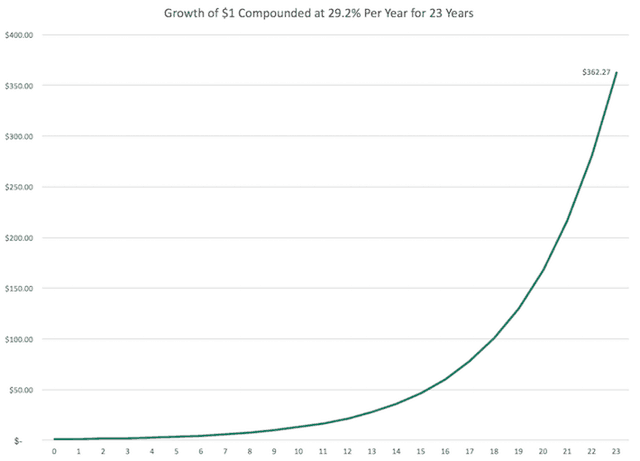The stories of Peter Lynch’s approach to stock investing

Contents
Who is Peter Lynch?
Peter Lynch is a legendary investor who in his 13 years (1977-1990) of running the Fidelity Magellan fund realized annual returns of 29.2% (362x investment).

Peter Lynch Quotes
- “Go for a business that any idiot can run – because sooner or later, any idiot is probably going to run it.”
- “Investing without research is like playing stud poker and never looking at the cards.”
- “The person that turns over the most rocks wins the game. And that’s always been my philosophy.”
- “You get recessions, you have stock market declines. If you don’t understand that’s going to happen, then you’re not ready, you won’t do well in the markets.”
- “Never invest in any idea you can’t illustrate with a crayon.”
- “There are substantial rewards for adopting a regular routine of investing and following it no matter what, and additional rewards for buying more shares when most investors are scared into selling.”
8 Principles of Stocks to Own
- Know what you own.
- It’s futile to predict the economy and interest rates.
- You have plenty of time to identify and recognize exceptional companies.
- Avoid long shots.
- Good management is very important – buy good businesses.
- Be flexible and humble, and learn from mistakes.
- Before you make a purchase, you should be able to explain why you’re buying.
- There’s always something to worry about.
3 Simple Lessons to Follow
- Do your homework: Research the company’s earnings prospects, financial condition, competitiveness, and other fundamentals.
- Utilize your edge: Invest in companies and industries you know well as your expertise advantage.
- Be patient: You will be unable to know how the market moves in the short term but long-term wise profits and markets tend to trend upwards.
“The simpler it is, the better I like it.”
3 C’s of Investing to Avoid
- Complacency: Buying a company and then forgetting or ignoring the business.
- Concern: Being overly concerned about the market/economy thus preventing taking up buy opportunities at bargain prices.
- Capitulation: Stock price falls below purchase price and selling it quickly to get out.

6 Stories of Stocks
Slow Growers
Large and aging companies expected to grow only slightly faster than the economy as a whole, but often paying large regular dividends.
- When to buy: Good dividend yield
- When to sell: 30% or above rise in prices, when fundamentals deteriorate, company losing market share, and making costly acquisitions.
Stalwarts
Large companies that are still able to grow, with annual earnings growth rates of around 10% to 12%. If purchased at a good price, expect good but not enormous returns. You can rotate among the companies, selling when moderate gains are reached, and repeating the process with others. Also offers downside protection during recessions.
- When to buy: Continued growth, and decent pricing.
- When to sell: Growth is slowing, sudden significant changes in PE, and cost cutting.
Fast-Growers
Small, aggressive companies with annual earnings growth of 20% to 25% a year. An investor’s biggest gains will come from this type of stock. However, they also carry high levels of risk.
- When to buy: Fast growing company (whether in fast or slow-growing industry).
- When to sell: Disappointing new store results, and comps down.
Cyclicals
Companies where sales and profits tend to rise and fall in predictable patterns based on the economic cycle. This includes sectors such as automobile, airlines, tires, steel, and chemical companies. Timing is crucial when investing in these companies and investors must learn to detect early signs that business is heading into a downtrend.
- When to buy: Beginning of the cycle, and growing demand for the company’s products.
- When to sell: Close to the end of the cycle, demand slowing for products, and cost competition from competitors.
Turnarounds
Companies that have been battered down or depressed. The stocks of successful turnarounds can move back up quickly at least related to the general market.
- When to buy: Companies bailed out by the government or other company with a strategic investment.
- When to sell: Increasing debt levels, inventories rising faster than sales, and decline in company’s major clients.
Asset Opportunities
Companies that have a lot of valuable assets like cash, lands or patents that is generally not known or seen, and negligible amounts of debt. Finding these hidden assets requires detailed working knowledge of the company that owns the assets. Your “edge” – your knowledge and experience can be used to great advantage.
- When to buy: Early on when most institutions/analysts are unaware of the assets.
- When to sell: Prices shoot up overly high above the value of its assets, and a significant increase in debt levels.
How can you apply Peter Lynch’s Principles?
- Review shares regularly and as often as you can as it is a numbers game. Buy good businesses that you know and understand.
- Long term, it is more important to invest and not try to time the market. Be patient when pulling the trigger on a stock.
- Recognize how the company you’re investing whether it fits one of the stock stories, and the behavior of the company.
At MyPF, our advisors and members look to practice the best approaches of great investors including Peter Lynch and Buffett. Learn more on investing with our free MyPF Premier trial or tap into our expertise with Active Advisory.
More: Peter Lynch’s Books





Leave A Comment